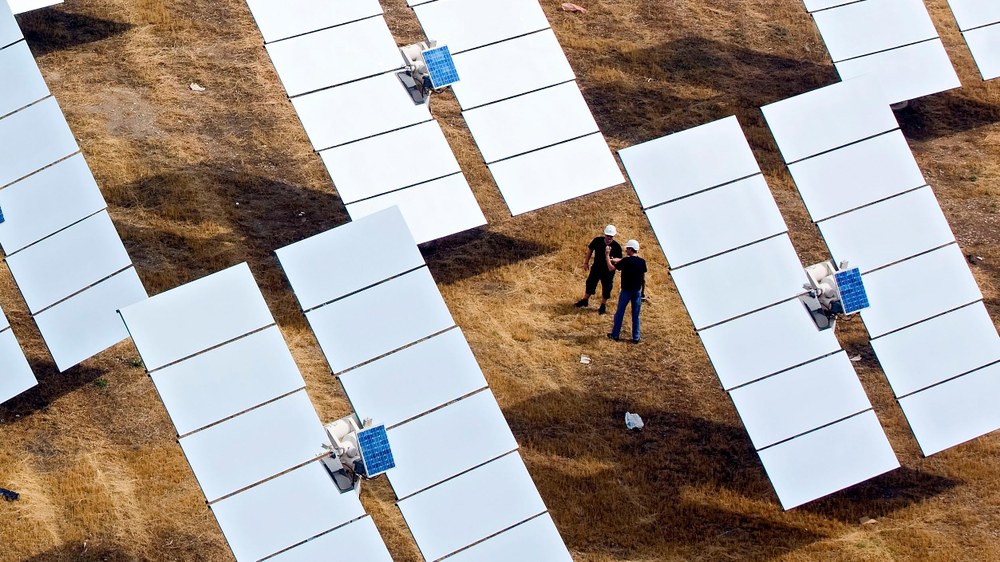DLR researchers want to stabilise power grids with publicly accessible cameras

- Precise predictions of where and how much the Sun is shining help operators of solar power plants and power grids to regulate them in a forward-looking way.
- Millions of cameras freely available on the Internet show their environment live. Researchers at the German Aerospace Center (DLR) want to use them to determine weather data in real time and thus improve radiation forecasts.
- Power grids can become more stable. In particular, small networks would benefit.
- Focus: energy, solar research, digitalisation, Big Data, Earth observation
Dealing with fluctuations in solar energy is one of the biggest challenges on the way to a sustainable energy supply. Researchers at the German Aerospace Center (Deutsches Zentrum für Luft- und Raumfahrt; DLR) are working on a technology that will hopefully make it possible to operate energy networks with a high proportion of solar energy in a more stable and efficient manner. The scientists' idea runs as follows: If the radiation forecasts are more accurate – for example when and how much sunshine there is in a particular place – the operators of power grids and solar plants will be able to react sooner. For example, if clouds – and thus performance losses – are announced in the next three minutes, reserve units and power plants could start up automatically and intervene within just a few seconds.
But weather satellites are not always sufficient for such accurate short-term forecasts. For example, in the best instance, the second-generation European Meteosat satellites update at five-minute intervals. At their highest resolution, one pixel is approximately one square kilometre. Also, satellites sometimes misinterpret weather conditions – snow and clouds, for example, can look almost identical from space. At such points, a DLR research team headed by Pascal Kuhn would like to back up the satellite data with additional information. "The Internet represents a real treasure trove for meteorology," Kuhn says. "The amount of freely available camera images is increasing swiftly, and in many places meteorological networks or touristic regions are filming the sky and the ground almost everywhere." An algorithm should derive relevant data and answer questions such as "Is it cloudy?", "Is there snow?" or "Are the clouds moving?"
This is how short-term forecasts should help with the energy turnaround
Improved radiation forecasts help to regulate power generation and consumption more dynamically. If the power drops off, reserve units and power plants can start up automatically and compensate for failures. If production peaks are predicted, solar producers could lower their production, or flexible consumers – such as hot water storage, cold stores, e-car chargers or pumped-storage power plants – could step in. "This would make the power grid smarter and could also partly reduce the need for expensive power storage such as batteries," Kuhn says. "Since predictions are significantly less expensive than electricity storage, innovations in this field are particularly important."
From test data sets, the researchers have identified the relevant parameters that need to be evaluated from the cameras and have examined data over a longer period of time.
The researchers want to collaborate with camera manufacturers in order to evaluate millions of photos in real time
The researchers have already solved a preliminary challenge. "With public cameras, many parameters are unknown, such as which direction they are pointing into the sky. But we have shown that robust algorithms can nevertheless derive the relevant weather data," Kuhn says. In the test phase, the researchers are working with images from the platform 'foto-webcam.eu'. Users upload hundreds of camera settings to the Internet free of charge, especially from the Alpine region. A 'Big Data solution' is another option. "Modern surveillance cameras are becoming increasingly smarter, so we would like to work with well-known manufacturers of surveillance cameras. If meteorological data are determined on site in the camera, not many images need to be transmitted, but only compact meta-data," Kuhn says.
Small power grids on islands or in remote regions could especially benefit
Kuhn's research is especially important for small power grids, so-called micro grids, with a high solar proportion. Micro grids can be found, for example, on islands and in remote regions. Since fluctuations in solar power generation are particularly high there, some of the countries have introduced so-called ramping restrictions. The output of solar power plants is therefore only allowed to fluctuate by a certain value compared with the previous minute. In Puerto Rico, for example, this is 10 percent. If the producers know about clouds a few minutes in advance, they can reduce their output or power up reserve units and better comply with the requirements.
The project
Kuhn's idea was awarded the DLR Innovation Prize in 2017 together with four other projects. The DLR Institute of Solar Research in Almería, Spain, is working on the project in the field of cameras. The DLR Institute of Networked Energy Systems in Oldenburg, Germany, is integrating the acquired data into existing satellite forecasts. The video material for the trial phase is being provided by the 'photo webcam' Internet platform. The project will run until November 2019.


